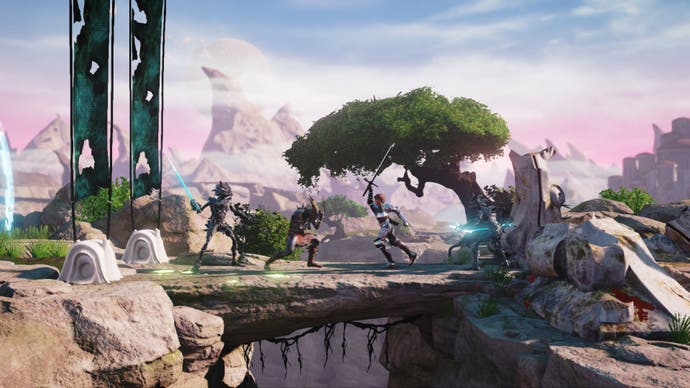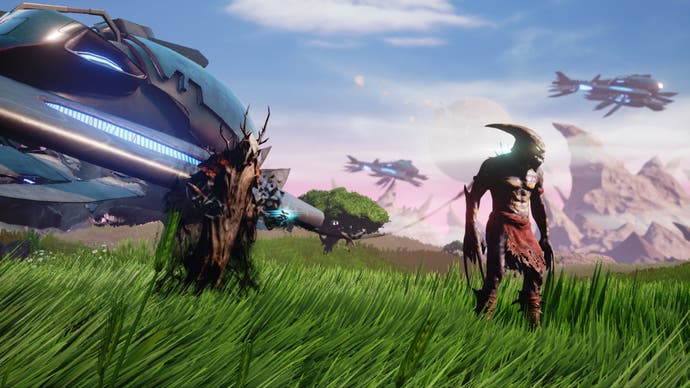Shadow of the Beast review
Amiga power.
Few video games have been as well served by their box art as the Commodore Amiga's Shadow of the Beast. Roger Dean's airbrushed panorama is both prehistoric and futuristic. It shows a thicket of rangy trees, each one blasted with red leaves, while, in the middle distance, two gleaming Jurassic contraptions pass one another, oblivious of us onlookers. The game's title, rendered in a scythe-like font, completes the alien, prog-rock aesthetic (Dean also drew covers for albums by Yes and Asia).
Box art is the art of promise. In 1989, when video game graphics were rudimentary, that promise also had to be something of an exaggeration, showing characters and scenes not as they appear on screen, but as they first appeared in the imagination of their creators. In Shadow of the Beast's case the hyperbole worked. The game proved vastly popular, sales further encouraged by a pack-in t-shirt bearing Dean's artwork.
The original Shadow of the Beast, in which you played as a kidnapped boy turned into a demonic brawler by a wizard's spell, was also loved for its technical competence. Shadow of the Beast and its two sequels, created by Martin Edmonson and Paul Howarth (who would later launch the Driver series), provided a technical benchmark, one that inspired a generation of up-and-coming British game-makers.
Beneath the graphical sheen, these were simple, often exasperating games from young, inexperienced designers. But this didn't stop many judging the games by their covers. Matt Birch was one of those who was enraptured. His fond memories playing the game at a friend's house aged 16 brought him to petition Sony to allow him to resurrect the series with his South London studio Heavy Spectrum.

It's relevant backstory. 2016's Shadow of the Beast is clearly a passion project from a man working on the game of his childhood dreams. In its most striking stage, we even have the chance to visit Dean's evocative landscape from the original cover. There a battle takes place atop one of the so-called 'Deanean Grazers', as it brushes that tree canopy of blazing rust. The credits betray the small scale of Heavy Spectrum's operation, but the team has nevertheless delivered generously. The full original game is included as an unlock (allowing everyone to see just how hard the 2016 team has had to work in order to make Shadow of the Beast's aged blueprint work in a contemporary context), along with a detailed retrospective of the original trilogy, and a series of videos that fill out the story of Aarbron, the tragic child turned blood-caked murderer.
Shadow of the Beast's violence is chaotic and brutal. Aarbron moves through the side-scrolling environments in a whirlwind of gore. You're not the only beast on the block. Throughout the game you'll encounter dagger-toothed monsters with muscular names. There are Trogoldytes (which roam the underground tunnels of Karamoon with viper mouths and bluebottle eyes), Dryads (jawless bispedal locusts that swing fiery maces that must be blocked before you can safely land an attack) and Dorogs (pack animals camouflaged by patches of moss sprouting from their arms.) Your Freddie Kruger-like claws can shorn the head clean from most foes, while Aarborn is able to pound the ground with both fists to cause a forest of spikes to erupt from the soil, puncturing any loiterers.
Despite its bluntness, there is a rhythm and dance to the violence. 2016's Shadow of the Beast has been recast as a score attack combat game. Portions of each stage are temporarily locked off with shimmering walls while you deal with the successive waves of incoming foes. Mostly, these monsters are combo fodder. You can stun, hurl, block and counter. You can leap toward enemies and, by plunging your claws into their bodies, refill you life, or simply hammer a button to suck further points from them. Certain moves require a blood meter to be filled, and so there is some technicality to your attack choices, depending on whether you need to store up blood or spend it. Take a hit and the multiplier resets to zero. Manage to keep the links going unscathed and your score will spiral pleasingly into the stratosphere. Still, it takes time to adjust to the game's rhythms of combat, which are never quite as smooth and intuitive as they could be.
Once each batch of enemies is dispatched you're awarded a medal for your efforts. Sustaining any more than a couple of hits from enemies will earn you the most shameful accolade, 'lead', while completing an encounter with the highest ranking will add an elixir to your store, the equivalent of an extra life. Stages vary wildly in length, but the more substantial locations are composed of around ten encounters, which are threaded together with platforming and, as in the original trilogy, some light puzzles, that have you, for example, finding your way through a warren of phosphorous teleporting tubes, flicking switches to temporarily unlock gates or, in the case of the final sprawling castle, leading wasps through darkened corridors.

All points earned translate to currency that can be used to upgrade Aarbron's abilities, extending his life or the power of his attacks (or to purchase concept art or, say, the ability to learn the various languages and dialects in the game thereby adding English subtitles). Points can also be spent on unlocking Talismans, power-enhancing items found in each stage's nooks that provide frustration-saving powers, such as the ability to survive a great fall. The level design veers between open-ended exploration and tightly scripted linearity. Each stage is nevertheless stuffed with weird secrets. You'll need to backtrack at seemingly illogical points to unlock some more challenging encounters, necessary scraps if you want to squeeze the maximum possible score from the stage.
In this way 2016's Shadow of the Beast evokes some of the mystery-kinks of its forebears. An arcane social feature, for example, allows you to periodically enter a so-called shadow realm where you undertake a button-mashing minigame in order to devour another player's avatar in as little amount of time as possible (this is by far the most grisly scene in the game, as you dismember your hapless target limb by limb). Doing so awards you a Shadow Stone, an item that allows you to summon beasts to fight alongside you during battles. While these curious interludes are hardly as beguiling as Dark Souls' invasions, they contribute to the sense that this is a somewhat textured and unusual game.
Those who share its developer's fondness for the source material, Shadow of the Beast may delight, even if, in 2016, the series strengths have now shifted away from technical mastery towards a clearer design and fuller backstory. It's a tougher sell for newcomers. There is a thrill to mastering the rhythmic, gruesome combat, but Shadow of the Beast lacks the refinement and grace of many of its peers. Elsewhere the game's explorative aspects feel undercooked. Still, the care that has gone into the development elevates the production. Undoubtedly Birch and his team have made an unusual game that carries with it the spirit of a lost era, for better and for worse.



